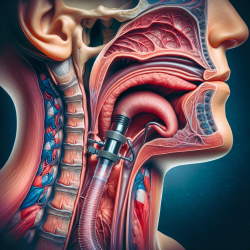Introduction
In the field of speech-language pathology, understanding the intricacies of swallowing function in patients with tracheotomy tubes is crucial. A recent study titled Pilot Date on Swallow Function in Nondysphagic Patients Requiring a Tracheotomy Tube sheds light on this topic, offering valuable insights for practitioners. This blog explores the study's findings and their implications for clinical practice.
Study Overview
The study aimed to evaluate the effects of tracheotomy tube occlusion status (open, finger, capped) and tube removal on bolus flow and durational measurements in nondysphagic individuals. Using a prospective, single-subject, repeated measure design, the researchers employed fiberoptic endoscopic examination of the swallow (FEES) to assess swallowing function.
Key Findings
- Aspiration: Aspiration was never observed in the study participants, indicating that the presence of a tracheotomy tube does not inherently increase aspiration risk in nondysphagic individuals.
- Laryngeal Penetration: Laryngeal penetration was a common finding, occurring under various occlusion conditions. However, no optimal occlusion condition was identified to eliminate this occurrence.
- Durational Measurements: The study found no significant differences in swallow initiation time or "white-out" duration across different occlusion statuses or after tube removal.
Implications for Practice
These findings suggest that the presence of a tracheotomy tube does not significantly impact swallowing function in nondysphagic patients. For practitioners, this underscores the importance of considering individual patient factors rather than assuming a direct correlation between tracheotomy tubes and swallowing dysfunction.
Moreover, the study highlights the need for further research with larger sample sizes and varied bolus consistencies to enhance our understanding of swallowing dynamics in this population.
Conclusion
Understanding the relationship between tracheotomy tubes and swallowing function is essential for effective dysphagia management. This study contributes valuable evidence to the field, encouraging practitioners to base their clinical decisions on data-driven insights.
To read the original research paper, please follow this link: Pilot Date on Swallow Function in Nondysphagic Patients Requiring a Tracheotomy Tube.










